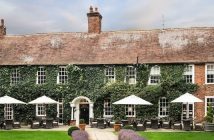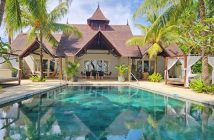The boat stopped and we waited in silent expectation as the morning sun beat down on our backs. Suddenly a silvery fin appeared, then two, then three. Soon we were surrounded by dolphins dipping and diving in and out of the water, their broad bodies shining like mercury in the sunlight. Cameras clicked frantically but I kept mine by my side, keen to experience the moment firsthand. They followed us for nearly an hour, quickening their pace when the boat accelerated. One youngster was particularly keen to impress, wowing us with a routine of twists and somersaults worthy of an Olympic diver. Awestruck, we spent the journey home reflecting on the magic we’d just witnessed.
The daylong voyage to the Maldives made our arrival in paradise all the sweeter. After two long flights came a final half-hour journey in a seaplane manned by a barefoot pilot who flew us past many of the archipelago’s tiny islands, which looked like amoeba under a microscope from up high. Landing on the water, after a quick boat ride we finally arrived, sticky and tired but buzzing with excitement. Stepping off the boat, I felt both elated and wistful, knowing that having witnessed such staggering beauty, I’ll have to spend the rest of my days yearning for it. The Maldives is the kind of earthly paradise you dream of and hope exists outside of your imagination. The sea is an endless expanse of aquamarine, as clear as glass and warm as bathwater. The blindingly white, sun-bleached sand like powder underfoot.

Made up of 1,190 coral islands of varying sizes, the 90,000 square kilometre archipelago is one of the world’s most dispersed countries. Its 26 atolls formed over millions of years from a volcanic mountain range rising out of the Indian Ocean. The smallest Asian country by land area and population, the Maldives lies southwest of India and Sri Lanka and is the lowest-lying nation in the world. Meaning “garland of islands” in Sanskrit, the archipelago was first Hindu, then Buddhist, and has been Islamic since the 12th century. Like Venice, the islands are at risk of being submerged due to rising sea levels, making the Maldives one of the most endangered nations on the planet.
My home for the next five nights was Coco Palm Dhuni Kolhu, a pristine, laid-back resort on the island of Baa Atoll offering everything from sailing, windsurfing, waterskiing and PADI diving courses to tennis, volleyball and beach yoga. Coco Palm is formed of 98 villas, including a cluster of thatched lagoon huts with private plunge pools that jut out into the big blue and offer honeymooners who don’t want to leave their love nest the option of spa treatments from the comfort of their own room. While it enjoys its status as the most lusted after (and Instragrammed) honeymoon destination, tourism didn’t take hold in the Maldives until the ‘70s. Today, just 185 of its islands are home to inhabitants. The others are used almost entirely for tourism.

After cooling off with an ice-cold hand towel in the resort’s shaded reception, I was shown to my dwelling, a deluxe villa with a conical roof nestled amid a canopy of palms on the eastern shores of the island. Exploring my surroundings, it soon became apparent that I had company – resting on my four-poster bed festooned with rose petals was a pair of swans crafted from bath towels. Popping open my welcome bottle of Champagne, I explored further, and discovered an open-air bathroom with an outdoor sunken bath. Mercifully, I didn’t have to disrobe to an audience, as the al fresco washrooms are entirely private. Keen to make the most of the afternoon sun after hours in the air, I took the Champagne outside, enjoying a flute in the plunge pool and another on a sun lounger on my own private patch of beach where the only things puncturing the silence were the odd squawking bird and the sound of the waves licking the shore. Before bed, I snuck out to lie on the lounger and look up at the blanket of stars above me dancing in the dark.
The next morning I braved the outdoor shower and found myself lathering up next to a lizard. While honeymooners walked dreamily arm in arm along the beach, our group of hacks was sent on an exciting adventure to a nearby desert island called Embudhoo. Slicing through the ocean at speed, we marveled as the palm-fringed island came into view. It’s hard to put into words just how exhilarating this felt, bringing my Robinson Crusoe fantasies to life. Having deposited us on the shore, our speedboat sped away leaving us utterly stranded, but in the most magnificent of circumstances. Brave honeymooners can spend the night alone on the island if they dare – we only got as far as lunch.

Free to roam, I set off alone to forage for shells and branches of bleached coral. Tiny crabs scuttled sideways across the sand with urgent intent, while an army of garrulous gulls circled overhead, their white bodies popping against the cloudless, brilliant blue sky. After a memorable picnic lunch on Embudhoo that included chunks of fresh coconut and hunks of local fish, back at Coco Palm it was time for the ultimate indulgence – a welcome massage of five stages that saw me scrubbed with coconut, drenched in coconut oil for the main massage, slathered in coconut moisturiser, then left to my own devices in a petal-strewn lemongrass, ginger, cinnamon and cardamom spice bath bobbing with slices of lemon to the sounds of Elton John’s greatest hits on the panpipes. I emerged energised and euphoric, my skin softer than goose down.
One of the world’s top diving destinations, Baa Atoll’s crystal clear waters are teeming with a kaleidoscope of tropical fish, colourful coral and magnificent manta rays the size of cars. Don a snorkel and a pair of flippers and during any one exploration you might encounter clownfish, lionfish, triggerfish, stonefish, pufferfish, batfish, angelfish, butterflyfish, and the wonderfully named oriental sweetlips, not to mention barracudas, stingrays and reef sharks.

Despite its abundance of marine life, certain sea dwellers can prove elusive. Our excursion in search of manta rays on the final day of our stay proved frustratingly fruitless. Named after the Spanish word for blanket due to their large flat shape, manta rays have a wingspan of up to seven metres and can weigh up to two tonnes. We boarded a blue boat and ventured to a part of the ocean where the captivating creatures can usually be found. Three separate attempts in different spots of the sea yielded nothing, hammering home how lucky we were with the dolphins. Coco Palm is dedicated to protecting local endangered species like sea turtles in partnership with the Olive Ridely Project and is fighting to rid the region of abandoned ‘ghost’ nets that entrap fish, dolphins and turtles, often leading to injury and sometimes death. The resort is so passionate in its plight that a turtle rescue centre is soon to open there, which will rehabilitate injured turtles until they’re ready to be released back into the wild. Sea turtles don’t have it easy. Just one in 100 eggs will make it into the sea and only one in 1,000 will live on into adulthood.
Keen to minimise its footprint on the island, Coco Palm offers guests free drinking water filtered on site and grows many of its ingredients within its grounds, including tomatoes, mint, basil and chili. The food offering at the resort is as delicious as it is abundant. My days begun with American pancakes topped with streaky bacon and drenched in maple syrup, followed by vivifying green chili omelets washed down with pineapple juice. Languorous lunches at its Cowrie restaurant featured fragrant salads, Bible-thick slices of tuna sashimi, Asian noodles, grilled fish with lemon butter, tandoori chicken and coconut rice.

The resort’s more formal restaurant, Cornus, specialises in Thai dishes like juicy king prawns with sweet chili dipping sauce served in a crispy cocoon; and aromatic stir fries sizzling with prawns, chili, garlic and hot basil. Such an authentic interpretation of Thai cuisine points to a highly accomplished chef. Over at the Conch bar our close-knit group of hacks stuck together, sinking Piña Coladas, Manhattans and Mai Tais, and telling ghost stories into the small hours.
On our final night, having watched the sun sink into the harbour, turning the sky into a haze of orange and pink, we got stuck into a bountiful beach barbecue involving whole grilled lobsters, giant meaty shrimp, juicy steaks, and feather-light herb-crusted grouper with coconut pesto. Rested and recharged, leaving Coco Palm the next morning was a wrench. Unsure if I’ll ever be lucky enough to return, I drunk in the scenery one last time, committing the view to memory. We boarded our seaplane for a second time, bound for Malé and the long journey home. Soaring into the sky, the ocean looked like a sheet of metal in the morning sun – flat, silver and smooth as a pebble.
Rates for an Ocean Front Villa start from £340 on a b&b basis, based on two people sharing. For more information on Coco Palm Dhuni Kolhu visit www.cocopalm.com.




